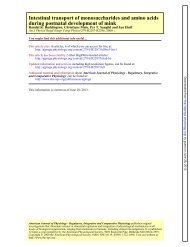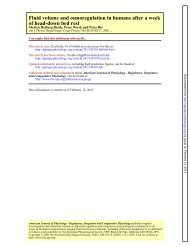Mechanical strain regulation of the Chicken glypican-4 gene ...
Mechanical strain regulation of the Chicken glypican-4 gene ...
Mechanical strain regulation of the Chicken glypican-4 gene ...
Create successful ePaper yourself
Turn your PDF publications into a flip-book with our unique Google optimized e-Paper software.
Rapid amplification <strong>of</strong> cDNA ends (RACE)<br />
Rapid amplification <strong>of</strong> cDNA ends (RACE), to complete <strong>the</strong> 3’ region <strong>of</strong> <strong>the</strong> chicken GPC-<br />
4, was performed with <strong>the</strong> SMART(TM) RACE cDNA amplification kit (Clontech)<br />
according to <strong>the</strong> manufacturer’s manual. In brief, <strong>the</strong> first strand cDNA was syn<strong>the</strong>sized<br />
from chicken ESG mRNA by means <strong>of</strong> <strong>the</strong> MMLV reverse transcriptase with <strong>the</strong> aid <strong>of</strong><br />
SMART II oligonucleotide and 3'-RACE cDNA syn<strong>the</strong>sis primers, at 42 0 C for 60 min.<br />
PCR was <strong>the</strong>n carried out with a 5’ <strong>gene</strong>-specific primer – 5’-<br />
GCTGGAGGGGCCTTTTAACATTGAGTC-3’ – syn<strong>the</strong>sized according to <strong>the</strong> cloned<br />
969-bp fragment and <strong>the</strong> mix <strong>of</strong> two universal adapter primers provided with <strong>the</strong> kit.<br />
Cycling conditions were: five cycles <strong>of</strong> 94 0 C for 15 s and 72 0 C for 3 min; five cycles <strong>of</strong><br />
94 0 C for 15 s, 70 0 C for 30 s and 72 0 C for 3 min; and 30 cycles <strong>of</strong> 94 0 C for 15 s, 68 0 C for<br />
30 s and 72 0 C for 3 min. A nested PCR reaction was carried out under similar conditions,<br />
with <strong>the</strong> kit primer (Nested Universal Primer) and a specific nested GPC-4 5’ primer (5'-<br />
GAACAGCATGCAAGTGTCTCA-3'). Figure 1 describes <strong>the</strong> strategy in <strong>the</strong> assembly <strong>of</strong><br />
<strong>the</strong> chicken GPC-4. The obtained PCR product was separated on 1% agarose and purified,<br />
cloned into <strong>the</strong> pGEM-T easy vector and sequenced from both directions with T7, SP6 and<br />
specific primers. The cDNA and deduced amino acid sequences were compared with <strong>the</strong><br />
DNA and protein databases at <strong>the</strong> National Center for Biotechnology Information.<br />
Preparation <strong>of</strong> riboprobe and in situ hybridization.<br />
A fragment <strong>of</strong> chicken GPC-4 cDNA (646bp) was syn<strong>the</strong>sized by reverse transcription<br />
(RT)-PCR from <strong>the</strong> chicken ESG (see under "RT-PCR"). This fragment shared no<br />
homology with any o<strong>the</strong>r known chicken cDNA and was subcloned into <strong>the</strong> pGEM-T<br />
Easy cloning vector to produce a template for riboprobe syn<strong>the</strong>sis. The sense and<br />
antisense riboprobes were syn<strong>the</strong>sized by in vitro transcription with T7 and SP6 RNA<br />
polymerase, respectively, in <strong>the</strong> presence <strong>of</strong> linearized plasmid DNA and DIG RNA<br />
labeling mix (Boehringer Mannheim, Ottweiler, Germany). Serial 5-µm sections <strong>of</strong> <strong>the</strong><br />
ESG or magnum were hybridized with a digoxigenin-labeled chicken GPC-4 probe as<br />
described previously (25). No hybridization was observed with <strong>the</strong> sense riboprobe,<br />
which was used as a negative control. Hybridization with avian �-actin probe was<br />
performed in order to rule out <strong>the</strong> possibility that changes in GPC-4 expression were due<br />
to variation in tissue processing and/or RNA preservation.<br />
8







